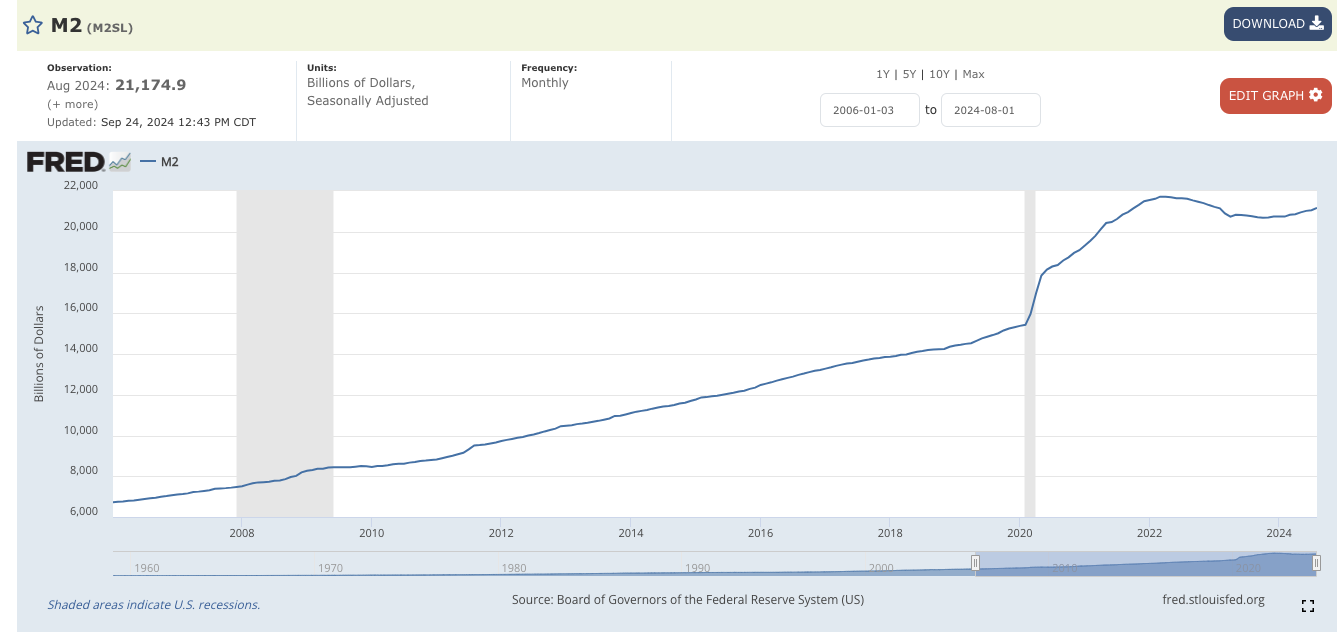(Mike Maharrey, Money Metals News Service) The so-called grownups tell us everything is fine. The inflation monster is gone now.
Or is it?
Sure, most people don’t believe it’s there, but I think the inflation monster is hiding under the bed. The adults in the room say it’s not there. But kiddos, there are signs — if you look close enough.
The headline number in last week’s September Consumer Price Index (CPI) report provides a false sense of security. Annual price inflation dropped to 2.4 percent, the lowest since February 2021.
Sounds as if we’re perfectly safe lying in our bed, right?
But look and listen a little more closely.
Prices rose 0.2 percent on a monthly basis. That was 0.1 percent higher than expectations and equaled the rate of price increases in August.
Still, not too concerning.
But the core CPI should raise eyebrows.
For the second straight month, core CPI (stripping out more volatile food and energy prices) rose by 0.3 percent, and the annual core inflation number ticked up from 3.2 percent in August to 3.3 percent in September. And if a 0.3 percent increase in core prices becomes a trend, that annualizes to 3.6 percent.
Core CPI has been above 3 percent for 41 months. That’s the longest span since the early 1990s.
Falling energy prices have provided a welcome downward tug on CPI, but they also obscure the reality of inflation. Energy prices dropped -1.9 percent on a monthly basis after falling 0.8 percent the previous month. Gasoline prices plunged -4.0 percent last month and have dropped -15.3 percent over the last year.
This explains why the core CPI rose last month even as the overall inflation rate dropped.
Keep in mind that the CPI doesn’t tell the entire story of inflation. If we simply rely on these government numbers, the monster will remain safely obscured. The government revised the CPI formula in the 1990s so that it understates the actual rise in prices. Based on the formula used in the 1970s, CPI is closer to double the official numbers. So, if the BLS was using the old formula, we’re looking at CPI closer to 6 percent. And using an honest formula, it would probably be worse than that.
Money Supply Is Growing – That’s Inflation!
Properly defined, inflation is an increase in the supply of money and credit. Price inflation is one symptom of this monetary inflation.
And the money supply is growing.
In other words, we are already back in an inflationary environment.
The M2 money supply bottomed one year ago at $20.60 trillion. Since then, it has crept upward. As of August, it was at 21.17 trillion. That’s the highest level since January 2023.
The money supply has grown on a year-over-year basis for five straight months.

M2 is just $548 billion from an all-time high.
As the Federal Reserve raised interest rates and shrunk its balance sheet, the money supply contracted sharply. In fact, it was the largest decline in the money supply since the Great Depression.
While this might seem impressive, it barely put a dent in the massive expansion of the money supply in the years after the 2008 financial crisis and during the pandemic. As Mises Institute senior editor Ryan McMaken noted, the recent contraction of the money supply “only puts a small dent in the huge edifice of newly created money.”
In other words, as aggressive as the Fed’s rate-cutting and balance sheet reduction was, it was a teardrop in the ocean compared to the amount of inflation created during the pandemic, not to mention in the wake of the 2008 financial crisis and Great Recession.
The Kobeissi Letter summed it up.
“After a brief decline, the quantity of money in the financial system is surging again, raising concerns about another inflation wave. Is inflation set for a comeback in 2025?”
It’s also notable that drops in the money supply usually precede recessions, but as McMaken pointed out, “Recessions tend not to become apparent until after the money supply has begun to accelerate again after a period of slowing. This was the case in the early 1990’s recession, the Dot-com Bust of 2001, and the Great Recession.”
The resurgence of money supply growth is, by definition, inflation. We are already seeing the result as stock market values increase. Whether this new round of inflationary activity finds its way into consumer prices remains to be seen, but the uptick in core CPI is cause for concern.
The Federal Reserve Has Surrendered to Inflation
Meanwhile, the Federal Reserve has effectively surrendered to inflation. Money supply growth will likely accelerate further after the central bank’s supersized 50 basis point rate cut in September.
This is a return to looser monetary policy. That means more credit expansion and more money flowing into the economy.
In other words, by declaring victory over price inflation and easing its monetary policy, the Fed is effectively committing to creating more inflation.
Even before the rate cut, the Fed was already winding down the inflation fight.
The central bank loosened monetary policy when it quietly announced that it would begin to taper balance sheet reduction in June.
The balance sheet serves as a direct pipeline to the money supply. When the Fed buys assets – primarily U.S. Treasuries and mortgage-backed securities – it does so with money created out of thin air. Those assets go on the balance sheet, and the new money gets injected into the economy.
Again – I can’t emphasize this enough – the expansion of the money supply is, by definition, inflation.
The inflation monster is alive and well. He’s snug as a bug in a rug under the bed, just waiting for the right time to come out and wreak more havoc.
Mike Maharrey is a journalist and market analyst for MoneyMetals.com with over a decade of experience in precious metals. He holds a BS in accounting from the University of Kentucky and a BA in journalism from the University of South Florida.

